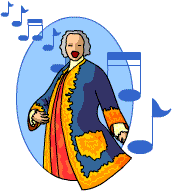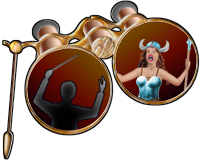Music Appreciation 101: Answers
Created | Updated Aug 27, 2012
And now for the moment of music truth. . .
Music Appreciation 101: Answers

- Tchaikovsky's '1812 Overture' uses what remarkable instrument?
A cannon. This can be startling to non-cognoscenti. Smirk when they jump at the finale of Tchaikovsky's celebration of Russian victory over Napoleon. Especially popular for US outdoor concerts on the 4th of July. - Opera is the most scandalous form of classical music. Why did German audiences object to Ludwig Spohr's Pietro de Abano in 1827?
It involved necrophilia. The plot of this opera, which was based on a story by Romantic writer Ludwig Tieck, revolves around a Faustian sorcerer. The fellow brings back a dead lady for immoral purposes. Sort of Buffy, the Vampire Slayer with fancy arias. We can't find you a sound sample, but the brave musicians of Leeds performed it in 2009. - Speaking of opera: the first-ever AM radio broadcast featured an opera aria about what?
A tree. The first song broadcast by AM radio, in 1906, was a recording of Handel's 'Ombra Mai Fu', from his opera Serse. The song is about a plane tree. It was a top-ten hit in the 18th Century, people. - What composer used disappearing musicians to drop a not-so-subtle hint to his boss that it was time for everybody to go home?
Haydn. That was a no-brainer: Papa Haydn was a musical jokester from way back, using his Surprise Symphony to wake up sleepy patrons. In his 'Farewell' Symphony, Haydn had musician after musician snuff out his candle and leave the concert hall until only he and the concertmaster were left playing violins. He wanted to draw attention to the fact that the musicians were tired of being at the summer palace, away from their wives, and wanted to go home. Prince Esterházy got the point: everybody left the next day. Smart man, Haydn. For technical reasons, we can't link to the symphony, but we recommend a stroll through Youtube. It's visually interesting. - Which of the following pieces of music was composed by someone who was completely deaf at the time?
'An die Freude'. Cecil Adams has 'The Straight Dope' on the story of Beethoven's being unable to hear the applause following the premiere of his great work, which moved people to tears. But the maestro probably wasn't conducting at the time. To think that he heard all that in his head. . . - Everybody knows that great classical composition by Jacques Offenbach called the 'can-can'. But where was this dance taking place?
In hell. The opera was called Orpheus in Hades, after all. Eurydice, Orpheus' ex, is happily dancing for her new bf, who happens to be the proprietor. (Changing your mind about opera, aren't you?) - Speaking of Offenbach's 'Can-Can', what did Camille Saint-Saëns do to this composition?
Played it really slowly. (You want number 22 on that link.) In his 'Carnival of the Animals', Saint-Saens decided the tortoises were dancing to this ditty. - Where was the Monty Python theme (yeah, sure, it's classical) first played?
On a Ferris wheel. At the 1893 Chicago Exposition, as a matter of fact, by composer John Philip Sousa's band, who were riding on the first Ferris wheel ever. The song is called 'The Liberty Bell March'. - What 'musical' instrument did John Cage use in a famous concert piece?
Typewriter. Several of them, in fact, in his 'Typewriter Piece'. And, ayup, that's concert stuff. These performers used Underwoods. - Which US President is a singing role in an opera by John Adams?
Richard M Nixon. No, US President Number Two didn't compose an opera about his old boss George Washington. Modern composer John Adams, however, came up with Nixon in China. Yes, this means you can have 'Henry Kissinger' in your repertoire. Once again, we can't link to the opera itself, but we really suggest you look at Youtube. The opening scene where the airplane lands is at least as much fun as the 'Triumphal March' from Aida.


We are sure you have now been converted to high-brow music. As usual, if you enjoyed this quiz, recommend it to your friends. Tell them you've become a culture vulture.

